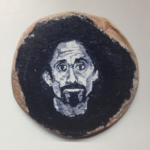
Charles Sexton
1957–1991
Introduction in catalog from Remains of the Day, curated by Rex Ray and Amy Scholder, 1992:
Charles Sexton and Jerome Caja met at the San Francisco Art Institute in the mid-1980s. They developed a friendship and evolved as artist. Each made very different choices in materials and styles - Jerome creates miniature paintings and assemblages on bottle caps, crushed cans, found metals, with nail polish, eyeliner, and white out; Charles made paintings on canvas and paper with oil and acrylics. Meanwhile they share certain preoccupations. The work in this exhibition explores sexual identity and cultural iconography, with an insistence on humor and pointing out the joke life plays on all.
Jerome Caja's anti-precious art objects have been called a collection of magic talisman against death. This art of excess and kitsch relentlessly documents the perversity of urban life. Charles Sexton's paintings and monotypes show how AIDS has ravaged his body and his imagination in a pervasive and totaling way. His most productive years were those following his diagnosis with HIV, and in many ways his artwork is a documentary of this revelation, illness, coming to terms with mortality, and ultimately his death. There autobiographical paintings are excruciatingly expressive of his fears of isolation and pain, and are at the same time romantic, sometimes pastoral visions of peace and resolution he sought in his final months.
Charles died on January 27, 1991 at the age of 34. Before he died, Charles made a pact with Jerome: his body would be cremated and with the ashes, Jerome would create works of art. Jerome created portraits of Charles with the ashes on lockets, bottle caps, tin cans and paper. This collection of images form an uncanny resemblance to Charles, and in fact, it is Charles.
https://soex.org/projects-exhibitions/remains-day
Profile photo: Untitled Portrait of Charles by Jerome Caja, 1992



